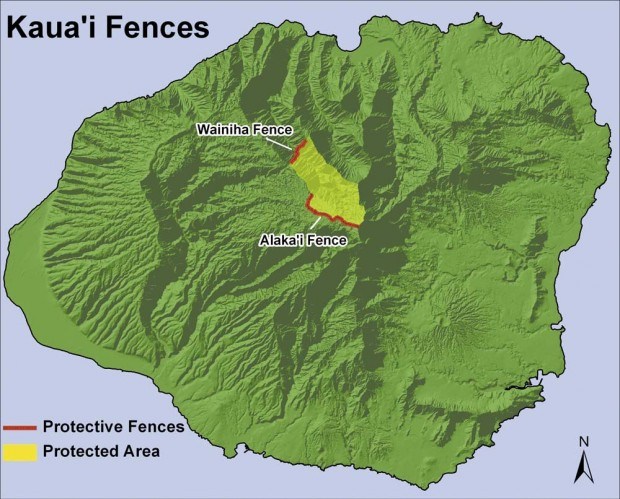A new pair of fences in the remote wilderness of Kaua‘i will reportedly protect the island’s primary source of water and one of the most important biological diversity hotspots in the Hawaiian archipelago. These strong barriers, developed by The Nature
A new pair of fences in the remote wilderness of Kaua‘i will reportedly protect the island’s primary source of water and one of the most important biological diversity hotspots in the Hawaiian archipelago.
These strong barriers, developed by The Nature Conservancy for the benefit of the Kaua‘i Watershed Alliance, will shelter 8,000 acres of the state’s most pristine wildland from the onslaught of invading feral animals, a news release states.
“These are just amazing areas. Everywhere you look, you are surrounded by incredible native Hawaiian birds, plants and insects. There is nowhere in the state like quite like it,” said Jeff Schlueter, Kaua‘i natural resource manager for The Nature Conservancy.
Ken Wood, a prominent biologist with the National Tropical Botanical Garden, which is a key partner in the Kaua‘i Alliance, said the biological diversity of the region is remarkable. He calls the area “one of the most important conservation sites in the entire archipelago.”
This land is also the core of the island’s watershed, a place where abundant rains and mists are soaked up and then feed the island’s rivers and its aquifer.
“These fences were conceived to protect the primary source of the island’s water supply. We needed to get the pigs and goats out because they were changing the ability of the forest to recharge our water resources,” said Trae Menard, the conservancy’s director of forest conservation.
One fence cuts through the Alaka‘i Swamp, and the other sweeps between cliff faces in upper Wainiha Valley, according to the news release from The Nature Conservancy. The 8,000 acres they protect lie in the heart of Kaua‘i areas so remote that crews and fencing materials had to be inserted by helicopter, and the work took almost 18 months.
Each fence is designed to prevent feral pigs and goats from gaining access to a wonderland of native flora and fauna. The fenced areas are home to some 300 endemic plant species, including 29 that are listed as endangered.
The 4.5-mile-long East Alaka‘i Protective Fence follows an L-shaped route through rugged upland bog-and-forest terrain and terminates at two sheer cliffs. Goats and pigs can’t get through it, and because of the cliffs, they can’t get around it, the release states.
The fence protects 2,000 acres that are home to a unique natural ecosystem and habitat for three endangered Hawaiian forest birds, the ‘akikiki, or Kaua‘i creeper; puaiohi, or Kaua‘i thrush; and ‘akeke‘e. Koloa ducks, Newell’s shearwaters and Hawaiian petrels are also found here.
The Wainiha Valley fence is just .3 miles long, taking advantage of sheer cliff walls of upper Wainiha Valley. It prevents mauka migration by feral animals into 6,000 acres of conservation land owned by McBryde Sugar Co. and managed by The Nature Conservancy as its Wainiha Preserve. Among the vast numbers of rare plants there is a native mint that was thought extinct until it was rediscovered at Hinalele Falls in the preserve in 2004.
The Nature Conservancy managed the two fencing projects for the benefit of the Kaua‘i Watershed Alliance, a consortium of wilderness landowners whose aim, in part, is to protect the watersheds of the island’s central mountain mass. The Alliance is a public-private partnership and the fences protect both public and private lands.
$700K fences protect private, public lands
The work was funded by the U.S. Fish and Wildlife Service’s Partners for Conservation and Endangered Species Recovery Programs, the U.S. Forest Service’s American Recovery and Reinvestment Act program, the state Division of Forestry and Wildlife’s Natural Area Reserve Fund’s Watershed Partnership Grant Program, and various private donors.
Built at a total cost of $700,000, the two fences will create the largest pig- and goat-free area on the island. The Alaka‘i and Wainiha projects employ a range of methods for removing the animals, including remotely operated traps, one-way baited gates and hunting.
The conservancy’s fencing contractor, Wellington Fencing Company, has extensive experience working in the remote back country of the island.
“Wellington brought to the project not only experience in fence construction, but experience in hunting. Being from Kaua‘i, they knew how the pigs behave and offered valuable insight into the design of the fence and what would keep feral animals out,” Menard said in the release.
Stewardship of these areas will be a continuing project of the conservancy and the alliance. The fencing projects will now be managed using remote surveillance technology, solar-powered radio repeaters, unique one-way baited gates, and a regular program of human inspection.
“Trees can fall on a fence and pigs can sometimes get in, so we need constant vigilance. We will continue to maintain these fences, keep them up, keep them solid,” Menard said.


